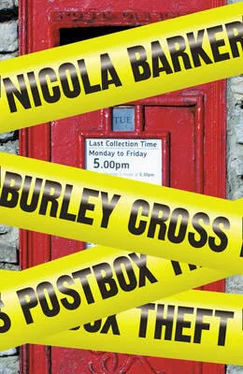Once the conservatory had been built, the former boundary of the brick wall was not then replaced — or even maintained (as you might imagine it should be) — but the entire area was subsequently cleared (denuded of bushes, borders etc.) and physically ‘opened up’.
By dint of this cunning manoeuvre, Ms Seymour has, effectively, turned the property around , i.e. the cottage formerly fronted straight on to the bypass, but she has now planted the — as then was — poky front garden with a thick line of Leylandii (which are already at head height), and seems intent — so far as one can tell — on using the lower reaches of Piper’s Ghyll Road as the main source of access to her home!
This access isn’t direct — as yet. Ms Seymour is far too canny for that! She insists that she is now using the tiny back alley that runs to the rear of the three cottages — formerly used only by the refuse disposal services — as her chief means of ingress and egress. This small, dank lane she has named ‘Paradise’ (and has even hung up a sign to this effect!).
I was perfectly astonished when I ventured down there the other week by what an amazing coup our humble Ms Seymour had pulled off (I honestly didn’t think she had it in her)! I promptly consulted a local estate agent (Rick Cullen, from Cullen and Speck) who told me that by suddenly, effectively , giving her home direct access to the lower reaches of Piper’s Ghyll Road (one of the most prestigious addresses in BC) she has added a sum of at least £30,000 to the value of her property!
It now seems as though there are moves afoot for the residents of the other two cottages to follow her lead (they’d be foolish not to, I suppose!).
I must confess that I find the ‘Paradise’ sign especially infuriating. Not only is the name utterly inappropriate to the location of the property (and the property itself), but it’s completely out of sync with other street names in BC. It simply isn’t kosher (there’s a silly, hippyish, deviant, almost heretical flavour to it). Worse still, it’s a long-held tradition in BC — as you will doubtless already know — that none of the roads (least of all imaginary ones!) have signs on them. That simply isn’t the way we do things here.
I have every reason to believe that Ms Seymour was compensated financially when the bypass was built, so find it doubly irritating that she has now connived to add extra value to the price of her ramshackle little abode by dint of completely disregarding local planning regulations etc.
I currently have two council lawyers working on the case. My main objective is to try and find out whether there might be any way to oblige her to return some of the original compensation she was paid, or possibly to force her — at the very least — to take down her silly sign and rebuild the old wall again (back at its original height of seven foot).
Of course you will know (possibly better than anybody) that if one person is seen to be ‘cocking a snook’ at planning regulations in a Conservation Area, then a very dangerous precedent is set, and all manner of breaches are liable to follow.
I mean whatever next, eh? A massage parlour on the High Street? Saxonby Manor turned into a temporary internment centre for asylum-seekers? The village church mysteriously transformed, overnight, into a functioning mosque?! Is nothing to be held sacred any more?
I’m sure there must be something that we can do to set right this awful wrong…
Yours, etc.
Baxter
PPS Am reduced to using snail mail due to a pesky virus on the Mac.
A dispatch from the desk of:
Baxter Thorndyke, Cllr
The Old Hall
Burley Cross
20/12/2006
For attn Sergeant Laurence Everill (Skipton) & PC Roger Topping (Ilkley)
Re Manhole cover theft
Gentlemen,
I am writing to you today in my capacity as an elected borough councillor and as a concerned — a very concerned — member of the Great British Public, about the burgeoning problem of manhole cover theft in the United Kingdom.
It is with a combination of astonishment and dismay that I am obliged to inform you that these apparently insignificant — you might think dreary, even inconsequential — items (a constituent part of every road and high street in the civilized world) have lately become the subject — the focus — of an organized, international crime wave, sponsored by no less an adversary than the Chinese.
If you are, as yet, unfamiliar with this startling phenomenon, do not be dismayed. I am more than happy to fill you in on everything you need to know…
The earliest, recorded cases of this heinous activity were registered approximately three or four years ago in the Far East. The thieves initiated this practice in China itself, then gradually began extending their tentacles into India (I presume certain cities and provinces in the Communist Republic started predating, like parasites, upon each other, before turning their greedy, pitiless eyes on to greater riches lying slightly further afield).
You may (or may not) be aware that this particular segment of the globe has been industrializing — at an extraordinary rate — over recent years, which (by necessity) has generated a powerful need for basic raw materials (coal, oil, steel). This need is now so immense, so boundless, that certain corrupt individuals within the Chinese establishment are willing to go to any lengths — I repeat: any lengths — to acquire the precious resources they so desperately hanker after.
An insignificant hunk of steel — the humble, utterly commonplace and dependable British manhole cover — has now become an essential nutrient in the ravening appetite — and overweening political ambitions — of the Communist Republic.
As I said previously, the earliest known cases of manhole cover theft took place within ‘the belly of the beast’ itself. In 2004 at least eight deaths were reported as a consequence of such thefts in India and China.
Deaths?
Hang on a second …
You are probably drawing back, startled, as your eyes re-run over those two, stark words. Eight deaths?!
‘But… but how …?’ you stutter.
I’ll tell you how:
The manhole cover might appear to be a piddling, paltry, even meritless object, in principle, but think about it, Constables: when one is stolen, what’s left behind is a whopping great hole for any innocent member of the public to tumble into (or drive over — generating horrendous damage to the wheels and bodywork of their vehicle — if the cover has been removed from the road itself).
This is a serious business. Still more serious when you consider how much these covers cost to replace. Steel yourselves, gentlemen (no pun intended): each individual cover costs in excess of £100.
Let me repeat that: in excess of £100 . And we aren’t talking insignificant numbers here, either. This is a massive, professional operation, a major enterprise. In 2004, over 10,000 manhole covers were stolen from the Indian city of Calcutta in a period of only two months. Do the maths. That’s around about 208 covers per night .
Baffled and infuriated by these thefts, the Indian authorities in that benighted slum replaced the steel covers with concrete ones, but were then appalled when these, too, were stolen — for the iron rods within the concrete!
Of course (I can hear you reasoning — and quite rightly) it is illegal for scrap dealers within the boundaries of the EU to purchase MHCs (Manhole covers).
Oh yes, it’s illegal all right, but — trust me — it sure as hell still happens. And anyway, the Chinese are just as likely to ship the stolen covers back to China on a cargo vessel and melt them down secretly there.
Читать дальше
Конец ознакомительного отрывка
Купить книгу












